Servant Leadership versus Authentic Leadership: Critique and Analysis
VerifiedAdded on 2022/10/09
|9
|3031
|125
Essay
AI Summary
This essay provides a detailed comparison of servant leadership and authentic leadership styles. It begins by defining and describing each leadership approach, highlighting their core principles and characteristics. Authentic leadership is presented as a style emphasizing self-awareness, integrity, and transparency, where leaders act in accordance with their values and inspire trust. Servant leadership, on the other hand, prioritizes serving others, fostering a supportive environment, and empowering team members. The essay then contrasts these two styles, outlining their differences in terms of focus, approach, and decision-making processes. It also explores the similarities between the two, such as their emphasis on building relationships and promoting ethical behavior. The essay further critiques both leadership styles, discussing their strengths, limitations, and effectiveness in different organizational contexts. The conclusion summarizes the key findings, emphasizing that while both styles offer valuable approaches to leadership, their effectiveness depends on the specific needs and goals of the organization.
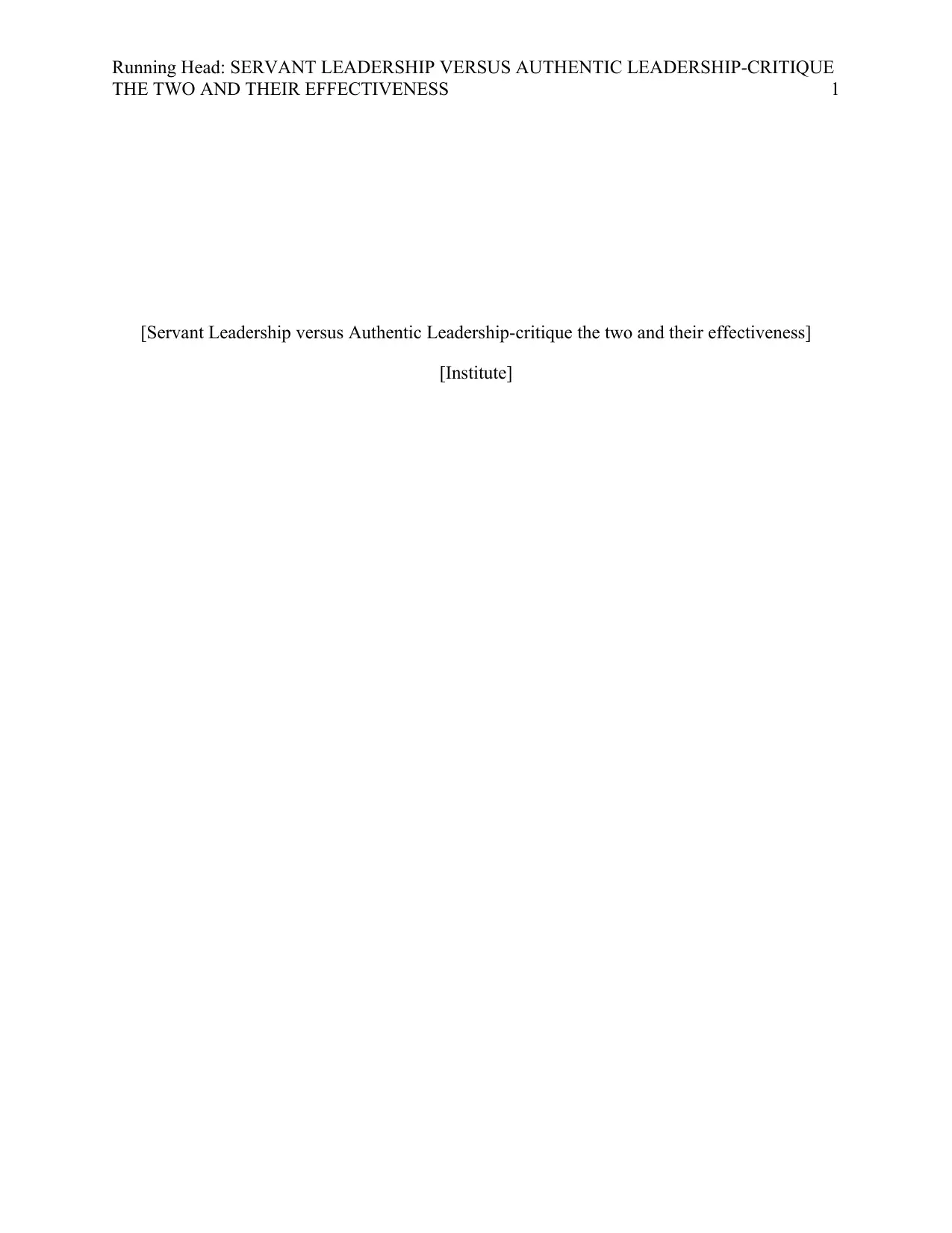
Running Head: SERVANT LEADERSHIP VERSUS AUTHENTIC LEADERSHIP-CRITIQUE
THE TWO AND THEIR EFFECTIVENESS 1
[Servant Leadership versus Authentic Leadership-critique the two and their effectiveness]
[Institute]
THE TWO AND THEIR EFFECTIVENESS 1
[Servant Leadership versus Authentic Leadership-critique the two and their effectiveness]
[Institute]
Paraphrase This Document
Need a fresh take? Get an instant paraphrase of this document with our AI Paraphraser
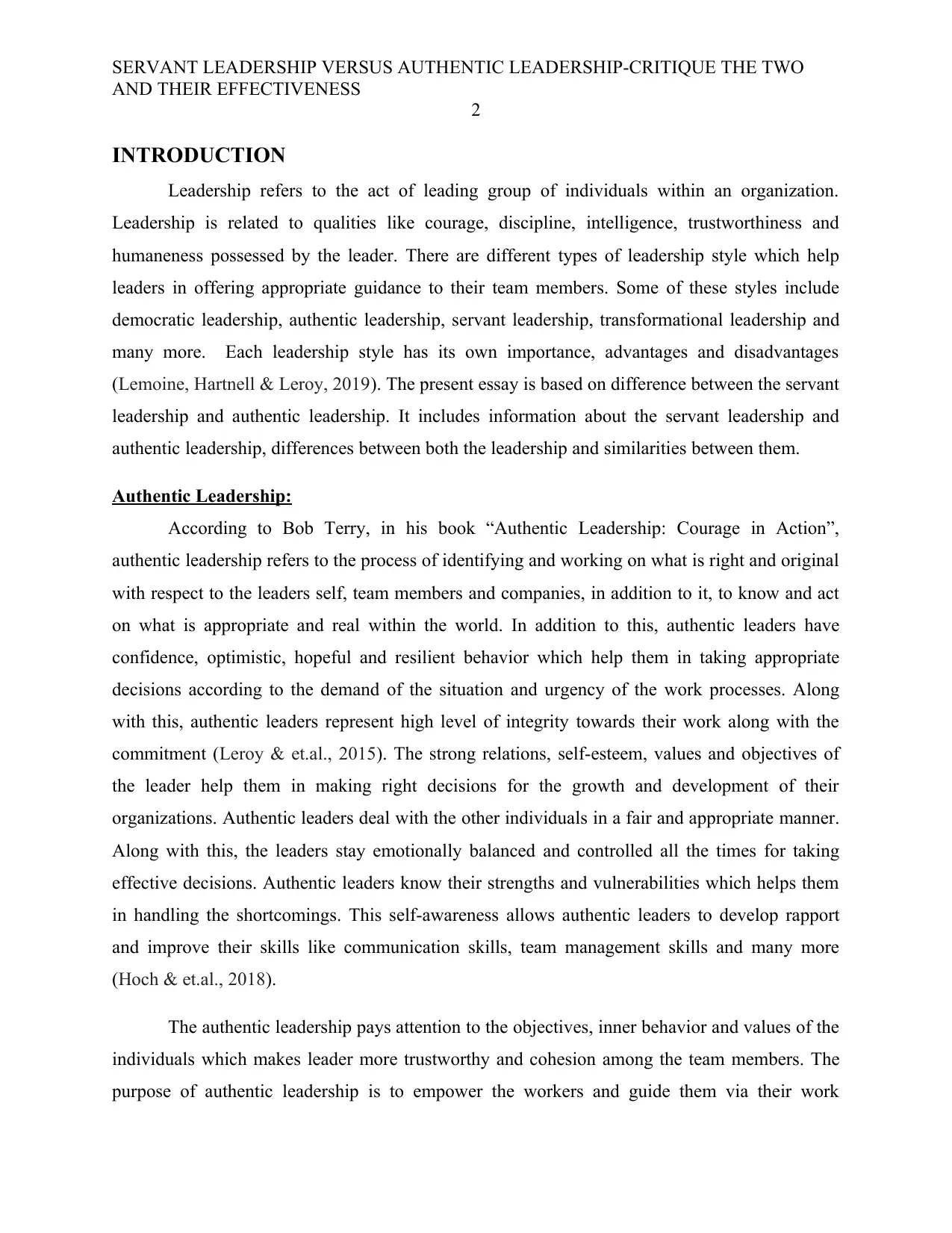
SERVANT LEADERSHIP VERSUS AUTHENTIC LEADERSHIP-CRITIQUE THE TWO
AND THEIR EFFECTIVENESS
2
INTRODUCTION
Leadership refers to the act of leading group of individuals within an organization.
Leadership is related to qualities like courage, discipline, intelligence, trustworthiness and
humaneness possessed by the leader. There are different types of leadership style which help
leaders in offering appropriate guidance to their team members. Some of these styles include
democratic leadership, authentic leadership, servant leadership, transformational leadership and
many more. Each leadership style has its own importance, advantages and disadvantages
(Lemoine, Hartnell & Leroy, 2019). The present essay is based on difference between the servant
leadership and authentic leadership. It includes information about the servant leadership and
authentic leadership, differences between both the leadership and similarities between them.
Authentic Leadership:
According to Bob Terry, in his book “Authentic Leadership: Courage in Action”,
authentic leadership refers to the process of identifying and working on what is right and original
with respect to the leaders self, team members and companies, in addition to it, to know and act
on what is appropriate and real within the world. In addition to this, authentic leaders have
confidence, optimistic, hopeful and resilient behavior which help them in taking appropriate
decisions according to the demand of the situation and urgency of the work processes. Along
with this, authentic leaders represent high level of integrity towards their work along with the
commitment (Leroy & et.al., 2015). The strong relations, self-esteem, values and objectives of
the leader help them in making right decisions for the growth and development of their
organizations. Authentic leaders deal with the other individuals in a fair and appropriate manner.
Along with this, the leaders stay emotionally balanced and controlled all the times for taking
effective decisions. Authentic leaders know their strengths and vulnerabilities which helps them
in handling the shortcomings. This self-awareness allows authentic leaders to develop rapport
and improve their skills like communication skills, team management skills and many more
(Hoch & et.al., 2018).
The authentic leadership pays attention to the objectives, inner behavior and values of the
individuals which makes leader more trustworthy and cohesion among the team members. The
purpose of authentic leadership is to empower the workers and guide them via their work
AND THEIR EFFECTIVENESS
2
INTRODUCTION
Leadership refers to the act of leading group of individuals within an organization.
Leadership is related to qualities like courage, discipline, intelligence, trustworthiness and
humaneness possessed by the leader. There are different types of leadership style which help
leaders in offering appropriate guidance to their team members. Some of these styles include
democratic leadership, authentic leadership, servant leadership, transformational leadership and
many more. Each leadership style has its own importance, advantages and disadvantages
(Lemoine, Hartnell & Leroy, 2019). The present essay is based on difference between the servant
leadership and authentic leadership. It includes information about the servant leadership and
authentic leadership, differences between both the leadership and similarities between them.
Authentic Leadership:
According to Bob Terry, in his book “Authentic Leadership: Courage in Action”,
authentic leadership refers to the process of identifying and working on what is right and original
with respect to the leaders self, team members and companies, in addition to it, to know and act
on what is appropriate and real within the world. In addition to this, authentic leaders have
confidence, optimistic, hopeful and resilient behavior which help them in taking appropriate
decisions according to the demand of the situation and urgency of the work processes. Along
with this, authentic leaders represent high level of integrity towards their work along with the
commitment (Leroy & et.al., 2015). The strong relations, self-esteem, values and objectives of
the leader help them in making right decisions for the growth and development of their
organizations. Authentic leaders deal with the other individuals in a fair and appropriate manner.
Along with this, the leaders stay emotionally balanced and controlled all the times for taking
effective decisions. Authentic leaders know their strengths and vulnerabilities which helps them
in handling the shortcomings. This self-awareness allows authentic leaders to develop rapport
and improve their skills like communication skills, team management skills and many more
(Hoch & et.al., 2018).
The authentic leadership pays attention to the objectives, inner behavior and values of the
individuals which makes leader more trustworthy and cohesion among the team members. The
purpose of authentic leadership is to empower the workers and guide them via their work
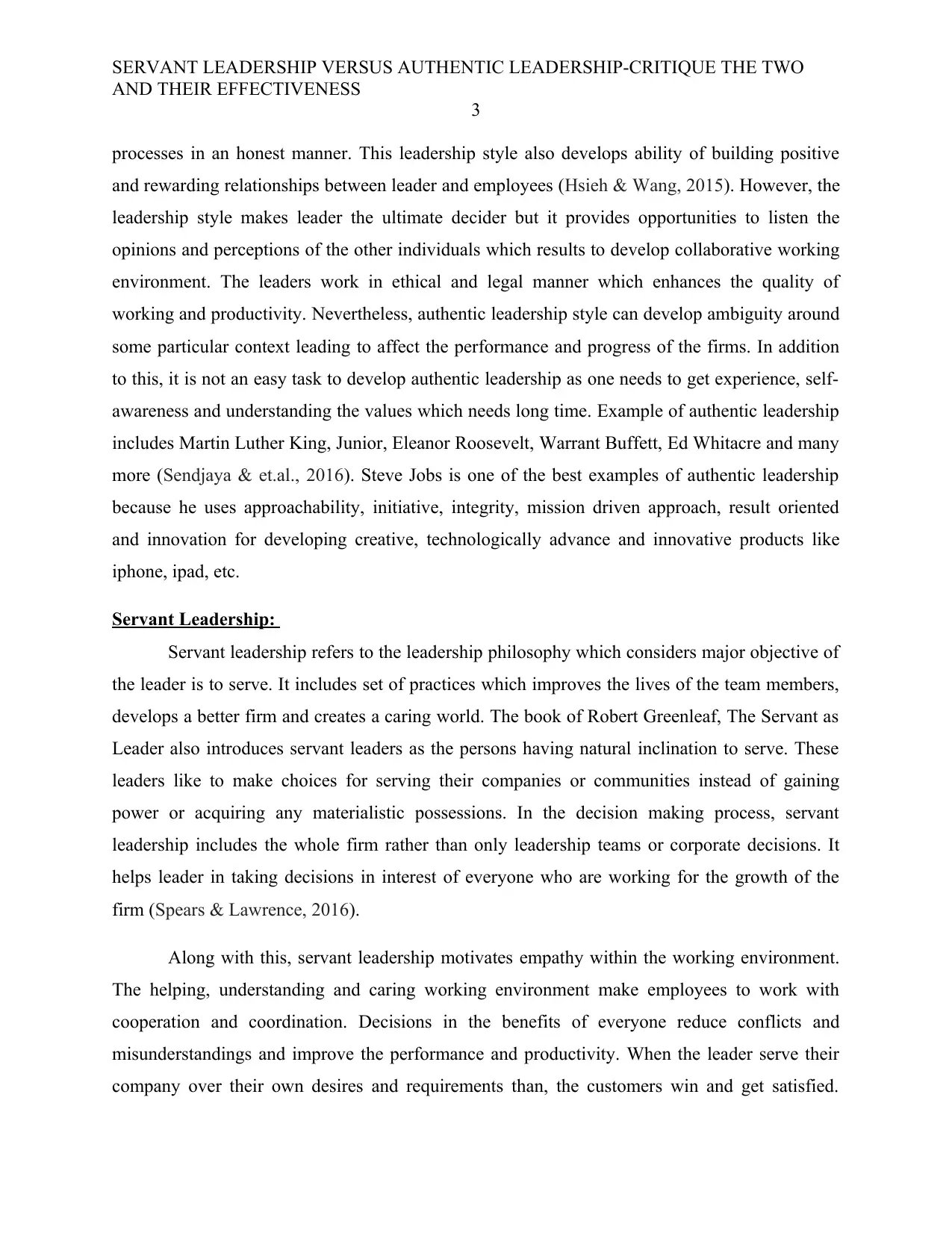
SERVANT LEADERSHIP VERSUS AUTHENTIC LEADERSHIP-CRITIQUE THE TWO
AND THEIR EFFECTIVENESS
3
processes in an honest manner. This leadership style also develops ability of building positive
and rewarding relationships between leader and employees (Hsieh & Wang, 2015). However, the
leadership style makes leader the ultimate decider but it provides opportunities to listen the
opinions and perceptions of the other individuals which results to develop collaborative working
environment. The leaders work in ethical and legal manner which enhances the quality of
working and productivity. Nevertheless, authentic leadership style can develop ambiguity around
some particular context leading to affect the performance and progress of the firms. In addition
to this, it is not an easy task to develop authentic leadership as one needs to get experience, self-
awareness and understanding the values which needs long time. Example of authentic leadership
includes Martin Luther King, Junior, Eleanor Roosevelt, Warrant Buffett, Ed Whitacre and many
more (Sendjaya & et.al., 2016). Steve Jobs is one of the best examples of authentic leadership
because he uses approachability, initiative, integrity, mission driven approach, result oriented
and innovation for developing creative, technologically advance and innovative products like
iphone, ipad, etc.
Servant Leadership:
Servant leadership refers to the leadership philosophy which considers major objective of
the leader is to serve. It includes set of practices which improves the lives of the team members,
develops a better firm and creates a caring world. The book of Robert Greenleaf, The Servant as
Leader also introduces servant leaders as the persons having natural inclination to serve. These
leaders like to make choices for serving their companies or communities instead of gaining
power or acquiring any materialistic possessions. In the decision making process, servant
leadership includes the whole firm rather than only leadership teams or corporate decisions. It
helps leader in taking decisions in interest of everyone who are working for the growth of the
firm (Spears & Lawrence, 2016).
Along with this, servant leadership motivates empathy within the working environment.
The helping, understanding and caring working environment make employees to work with
cooperation and coordination. Decisions in the benefits of everyone reduce conflicts and
misunderstandings and improve the performance and productivity. When the leader serve their
company over their own desires and requirements than, the customers win and get satisfied.
AND THEIR EFFECTIVENESS
3
processes in an honest manner. This leadership style also develops ability of building positive
and rewarding relationships between leader and employees (Hsieh & Wang, 2015). However, the
leadership style makes leader the ultimate decider but it provides opportunities to listen the
opinions and perceptions of the other individuals which results to develop collaborative working
environment. The leaders work in ethical and legal manner which enhances the quality of
working and productivity. Nevertheless, authentic leadership style can develop ambiguity around
some particular context leading to affect the performance and progress of the firms. In addition
to this, it is not an easy task to develop authentic leadership as one needs to get experience, self-
awareness and understanding the values which needs long time. Example of authentic leadership
includes Martin Luther King, Junior, Eleanor Roosevelt, Warrant Buffett, Ed Whitacre and many
more (Sendjaya & et.al., 2016). Steve Jobs is one of the best examples of authentic leadership
because he uses approachability, initiative, integrity, mission driven approach, result oriented
and innovation for developing creative, technologically advance and innovative products like
iphone, ipad, etc.
Servant Leadership:
Servant leadership refers to the leadership philosophy which considers major objective of
the leader is to serve. It includes set of practices which improves the lives of the team members,
develops a better firm and creates a caring world. The book of Robert Greenleaf, The Servant as
Leader also introduces servant leaders as the persons having natural inclination to serve. These
leaders like to make choices for serving their companies or communities instead of gaining
power or acquiring any materialistic possessions. In the decision making process, servant
leadership includes the whole firm rather than only leadership teams or corporate decisions. It
helps leader in taking decisions in interest of everyone who are working for the growth of the
firm (Spears & Lawrence, 2016).
Along with this, servant leadership motivates empathy within the working environment.
The helping, understanding and caring working environment make employees to work with
cooperation and coordination. Decisions in the benefits of everyone reduce conflicts and
misunderstandings and improve the performance and productivity. When the leader serve their
company over their own desires and requirements than, the customers win and get satisfied.
⊘ This is a preview!⊘
Do you want full access?
Subscribe today to unlock all pages.

Trusted by 1+ million students worldwide
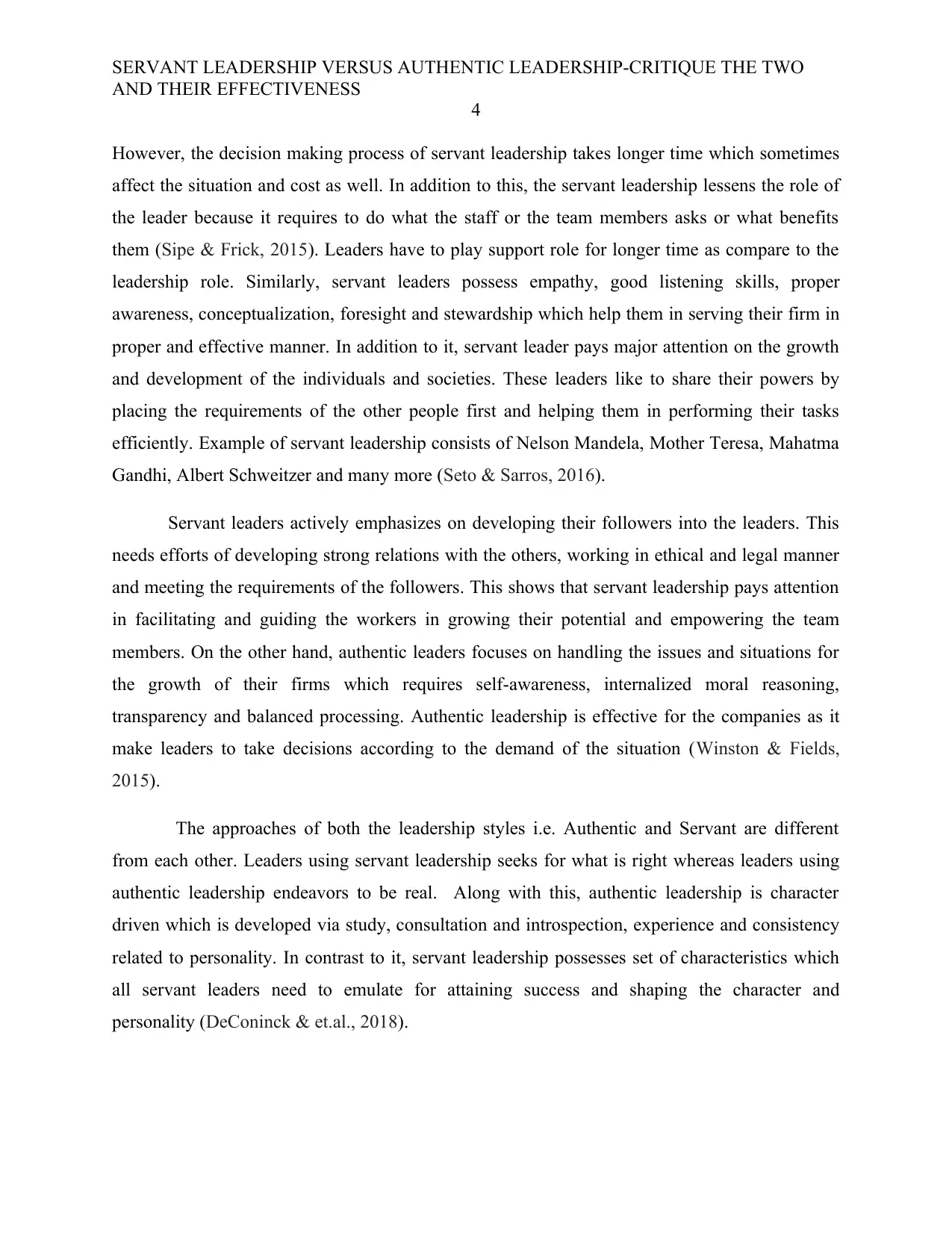
SERVANT LEADERSHIP VERSUS AUTHENTIC LEADERSHIP-CRITIQUE THE TWO
AND THEIR EFFECTIVENESS
4
However, the decision making process of servant leadership takes longer time which sometimes
affect the situation and cost as well. In addition to this, the servant leadership lessens the role of
the leader because it requires to do what the staff or the team members asks or what benefits
them (Sipe & Frick, 2015). Leaders have to play support role for longer time as compare to the
leadership role. Similarly, servant leaders possess empathy, good listening skills, proper
awareness, conceptualization, foresight and stewardship which help them in serving their firm in
proper and effective manner. In addition to it, servant leader pays major attention on the growth
and development of the individuals and societies. These leaders like to share their powers by
placing the requirements of the other people first and helping them in performing their tasks
efficiently. Example of servant leadership consists of Nelson Mandela, Mother Teresa, Mahatma
Gandhi, Albert Schweitzer and many more (Seto & Sarros, 2016).
Servant leaders actively emphasizes on developing their followers into the leaders. This
needs efforts of developing strong relations with the others, working in ethical and legal manner
and meeting the requirements of the followers. This shows that servant leadership pays attention
in facilitating and guiding the workers in growing their potential and empowering the team
members. On the other hand, authentic leaders focuses on handling the issues and situations for
the growth of their firms which requires self-awareness, internalized moral reasoning,
transparency and balanced processing. Authentic leadership is effective for the companies as it
make leaders to take decisions according to the demand of the situation (Winston & Fields,
2015).
The approaches of both the leadership styles i.e. Authentic and Servant are different
from each other. Leaders using servant leadership seeks for what is right whereas leaders using
authentic leadership endeavors to be real. Along with this, authentic leadership is character
driven which is developed via study, consultation and introspection, experience and consistency
related to personality. In contrast to it, servant leadership possesses set of characteristics which
all servant leaders need to emulate for attaining success and shaping the character and
personality (DeConinck & et.al., 2018).
AND THEIR EFFECTIVENESS
4
However, the decision making process of servant leadership takes longer time which sometimes
affect the situation and cost as well. In addition to this, the servant leadership lessens the role of
the leader because it requires to do what the staff or the team members asks or what benefits
them (Sipe & Frick, 2015). Leaders have to play support role for longer time as compare to the
leadership role. Similarly, servant leaders possess empathy, good listening skills, proper
awareness, conceptualization, foresight and stewardship which help them in serving their firm in
proper and effective manner. In addition to it, servant leader pays major attention on the growth
and development of the individuals and societies. These leaders like to share their powers by
placing the requirements of the other people first and helping them in performing their tasks
efficiently. Example of servant leadership consists of Nelson Mandela, Mother Teresa, Mahatma
Gandhi, Albert Schweitzer and many more (Seto & Sarros, 2016).
Servant leaders actively emphasizes on developing their followers into the leaders. This
needs efforts of developing strong relations with the others, working in ethical and legal manner
and meeting the requirements of the followers. This shows that servant leadership pays attention
in facilitating and guiding the workers in growing their potential and empowering the team
members. On the other hand, authentic leaders focuses on handling the issues and situations for
the growth of their firms which requires self-awareness, internalized moral reasoning,
transparency and balanced processing. Authentic leadership is effective for the companies as it
make leaders to take decisions according to the demand of the situation (Winston & Fields,
2015).
The approaches of both the leadership styles i.e. Authentic and Servant are different
from each other. Leaders using servant leadership seeks for what is right whereas leaders using
authentic leadership endeavors to be real. Along with this, authentic leadership is character
driven which is developed via study, consultation and introspection, experience and consistency
related to personality. In contrast to it, servant leadership possesses set of characteristics which
all servant leaders need to emulate for attaining success and shaping the character and
personality (DeConinck & et.al., 2018).
Paraphrase This Document
Need a fresh take? Get an instant paraphrase of this document with our AI Paraphraser
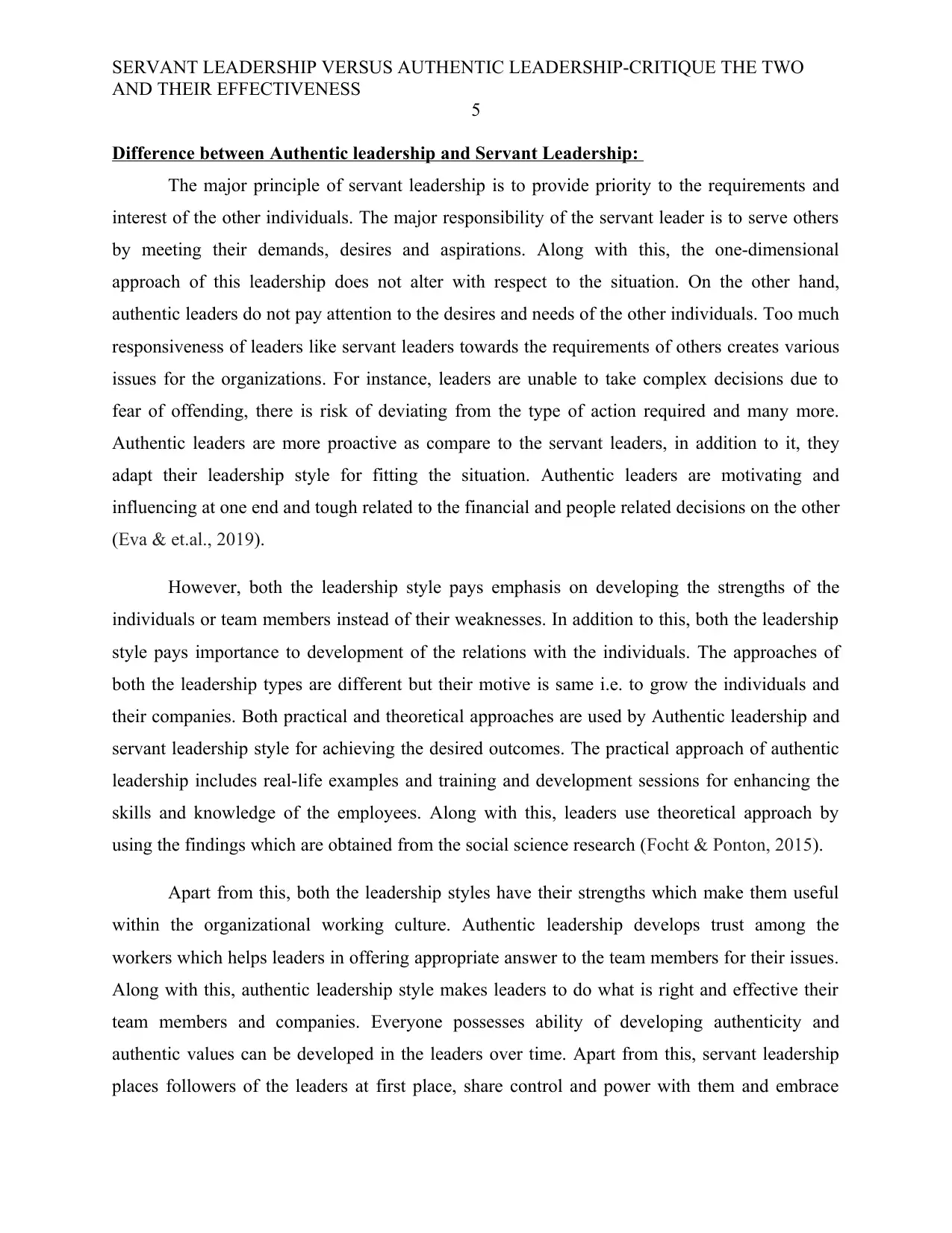
SERVANT LEADERSHIP VERSUS AUTHENTIC LEADERSHIP-CRITIQUE THE TWO
AND THEIR EFFECTIVENESS
5
Difference between Authentic leadership and Servant Leadership:
The major principle of servant leadership is to provide priority to the requirements and
interest of the other individuals. The major responsibility of the servant leader is to serve others
by meeting their demands, desires and aspirations. Along with this, the one-dimensional
approach of this leadership does not alter with respect to the situation. On the other hand,
authentic leaders do not pay attention to the desires and needs of the other individuals. Too much
responsiveness of leaders like servant leaders towards the requirements of others creates various
issues for the organizations. For instance, leaders are unable to take complex decisions due to
fear of offending, there is risk of deviating from the type of action required and many more.
Authentic leaders are more proactive as compare to the servant leaders, in addition to it, they
adapt their leadership style for fitting the situation. Authentic leaders are motivating and
influencing at one end and tough related to the financial and people related decisions on the other
(Eva & et.al., 2019).
However, both the leadership style pays emphasis on developing the strengths of the
individuals or team members instead of their weaknesses. In addition to this, both the leadership
style pays importance to development of the relations with the individuals. The approaches of
both the leadership types are different but their motive is same i.e. to grow the individuals and
their companies. Both practical and theoretical approaches are used by Authentic leadership and
servant leadership style for achieving the desired outcomes. The practical approach of authentic
leadership includes real-life examples and training and development sessions for enhancing the
skills and knowledge of the employees. Along with this, leaders use theoretical approach by
using the findings which are obtained from the social science research (Focht & Ponton, 2015).
Apart from this, both the leadership styles have their strengths which make them useful
within the organizational working culture. Authentic leadership develops trust among the
workers which helps leaders in offering appropriate answer to the team members for their issues.
Along with this, authentic leadership style makes leaders to do what is right and effective their
team members and companies. Everyone possesses ability of developing authenticity and
authentic values can be developed in the leaders over time. Apart from this, servant leadership
places followers of the leaders at first place, share control and power with them and embrace
AND THEIR EFFECTIVENESS
5
Difference between Authentic leadership and Servant Leadership:
The major principle of servant leadership is to provide priority to the requirements and
interest of the other individuals. The major responsibility of the servant leader is to serve others
by meeting their demands, desires and aspirations. Along with this, the one-dimensional
approach of this leadership does not alter with respect to the situation. On the other hand,
authentic leaders do not pay attention to the desires and needs of the other individuals. Too much
responsiveness of leaders like servant leaders towards the requirements of others creates various
issues for the organizations. For instance, leaders are unable to take complex decisions due to
fear of offending, there is risk of deviating from the type of action required and many more.
Authentic leaders are more proactive as compare to the servant leaders, in addition to it, they
adapt their leadership style for fitting the situation. Authentic leaders are motivating and
influencing at one end and tough related to the financial and people related decisions on the other
(Eva & et.al., 2019).
However, both the leadership style pays emphasis on developing the strengths of the
individuals or team members instead of their weaknesses. In addition to this, both the leadership
style pays importance to development of the relations with the individuals. The approaches of
both the leadership types are different but their motive is same i.e. to grow the individuals and
their companies. Both practical and theoretical approaches are used by Authentic leadership and
servant leadership style for achieving the desired outcomes. The practical approach of authentic
leadership includes real-life examples and training and development sessions for enhancing the
skills and knowledge of the employees. Along with this, leaders use theoretical approach by
using the findings which are obtained from the social science research (Focht & Ponton, 2015).
Apart from this, both the leadership styles have their strengths which make them useful
within the organizational working culture. Authentic leadership develops trust among the
workers which helps leaders in offering appropriate answer to the team members for their issues.
Along with this, authentic leadership style makes leaders to do what is right and effective their
team members and companies. Everyone possesses ability of developing authenticity and
authentic values can be developed in the leaders over time. Apart from this, servant leadership
places followers of the leaders at first place, share control and power with them and embrace
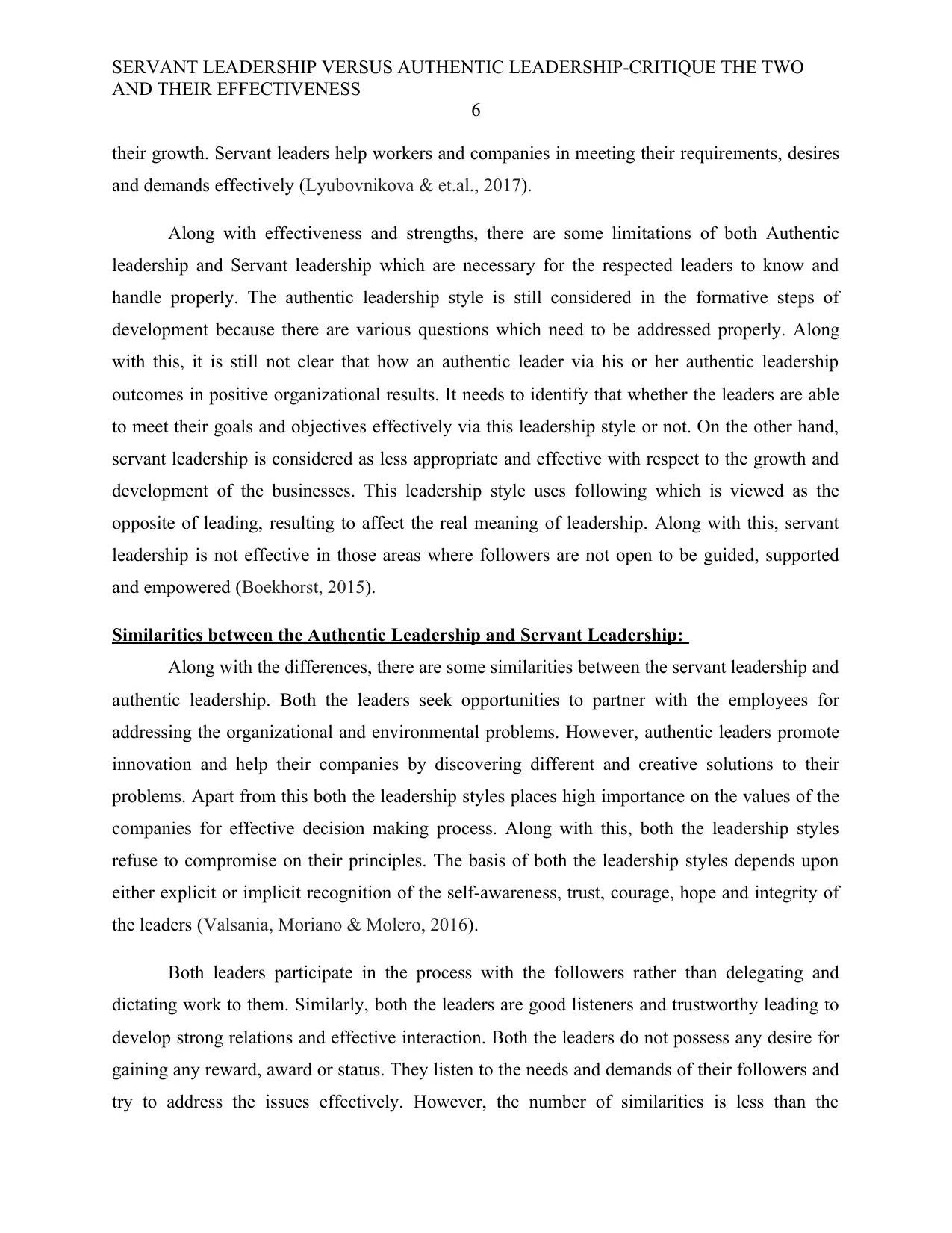
SERVANT LEADERSHIP VERSUS AUTHENTIC LEADERSHIP-CRITIQUE THE TWO
AND THEIR EFFECTIVENESS
6
their growth. Servant leaders help workers and companies in meeting their requirements, desires
and demands effectively (Lyubovnikova & et.al., 2017).
Along with effectiveness and strengths, there are some limitations of both Authentic
leadership and Servant leadership which are necessary for the respected leaders to know and
handle properly. The authentic leadership style is still considered in the formative steps of
development because there are various questions which need to be addressed properly. Along
with this, it is still not clear that how an authentic leader via his or her authentic leadership
outcomes in positive organizational results. It needs to identify that whether the leaders are able
to meet their goals and objectives effectively via this leadership style or not. On the other hand,
servant leadership is considered as less appropriate and effective with respect to the growth and
development of the businesses. This leadership style uses following which is viewed as the
opposite of leading, resulting to affect the real meaning of leadership. Along with this, servant
leadership is not effective in those areas where followers are not open to be guided, supported
and empowered (Boekhorst, 2015).
Similarities between the Authentic Leadership and Servant Leadership:
Along with the differences, there are some similarities between the servant leadership and
authentic leadership. Both the leaders seek opportunities to partner with the employees for
addressing the organizational and environmental problems. However, authentic leaders promote
innovation and help their companies by discovering different and creative solutions to their
problems. Apart from this both the leadership styles places high importance on the values of the
companies for effective decision making process. Along with this, both the leadership styles
refuse to compromise on their principles. The basis of both the leadership styles depends upon
either explicit or implicit recognition of the self-awareness, trust, courage, hope and integrity of
the leaders (Valsania, Moriano & Molero, 2016).
Both leaders participate in the process with the followers rather than delegating and
dictating work to them. Similarly, both the leaders are good listeners and trustworthy leading to
develop strong relations and effective interaction. Both the leaders do not possess any desire for
gaining any reward, award or status. They listen to the needs and demands of their followers and
try to address the issues effectively. However, the number of similarities is less than the
AND THEIR EFFECTIVENESS
6
their growth. Servant leaders help workers and companies in meeting their requirements, desires
and demands effectively (Lyubovnikova & et.al., 2017).
Along with effectiveness and strengths, there are some limitations of both Authentic
leadership and Servant leadership which are necessary for the respected leaders to know and
handle properly. The authentic leadership style is still considered in the formative steps of
development because there are various questions which need to be addressed properly. Along
with this, it is still not clear that how an authentic leader via his or her authentic leadership
outcomes in positive organizational results. It needs to identify that whether the leaders are able
to meet their goals and objectives effectively via this leadership style or not. On the other hand,
servant leadership is considered as less appropriate and effective with respect to the growth and
development of the businesses. This leadership style uses following which is viewed as the
opposite of leading, resulting to affect the real meaning of leadership. Along with this, servant
leadership is not effective in those areas where followers are not open to be guided, supported
and empowered (Boekhorst, 2015).
Similarities between the Authentic Leadership and Servant Leadership:
Along with the differences, there are some similarities between the servant leadership and
authentic leadership. Both the leaders seek opportunities to partner with the employees for
addressing the organizational and environmental problems. However, authentic leaders promote
innovation and help their companies by discovering different and creative solutions to their
problems. Apart from this both the leadership styles places high importance on the values of the
companies for effective decision making process. Along with this, both the leadership styles
refuse to compromise on their principles. The basis of both the leadership styles depends upon
either explicit or implicit recognition of the self-awareness, trust, courage, hope and integrity of
the leaders (Valsania, Moriano & Molero, 2016).
Both leaders participate in the process with the followers rather than delegating and
dictating work to them. Similarly, both the leaders are good listeners and trustworthy leading to
develop strong relations and effective interaction. Both the leaders do not possess any desire for
gaining any reward, award or status. They listen to the needs and demands of their followers and
try to address the issues effectively. However, the number of similarities is less than the
⊘ This is a preview!⊘
Do you want full access?
Subscribe today to unlock all pages.

Trusted by 1+ million students worldwide
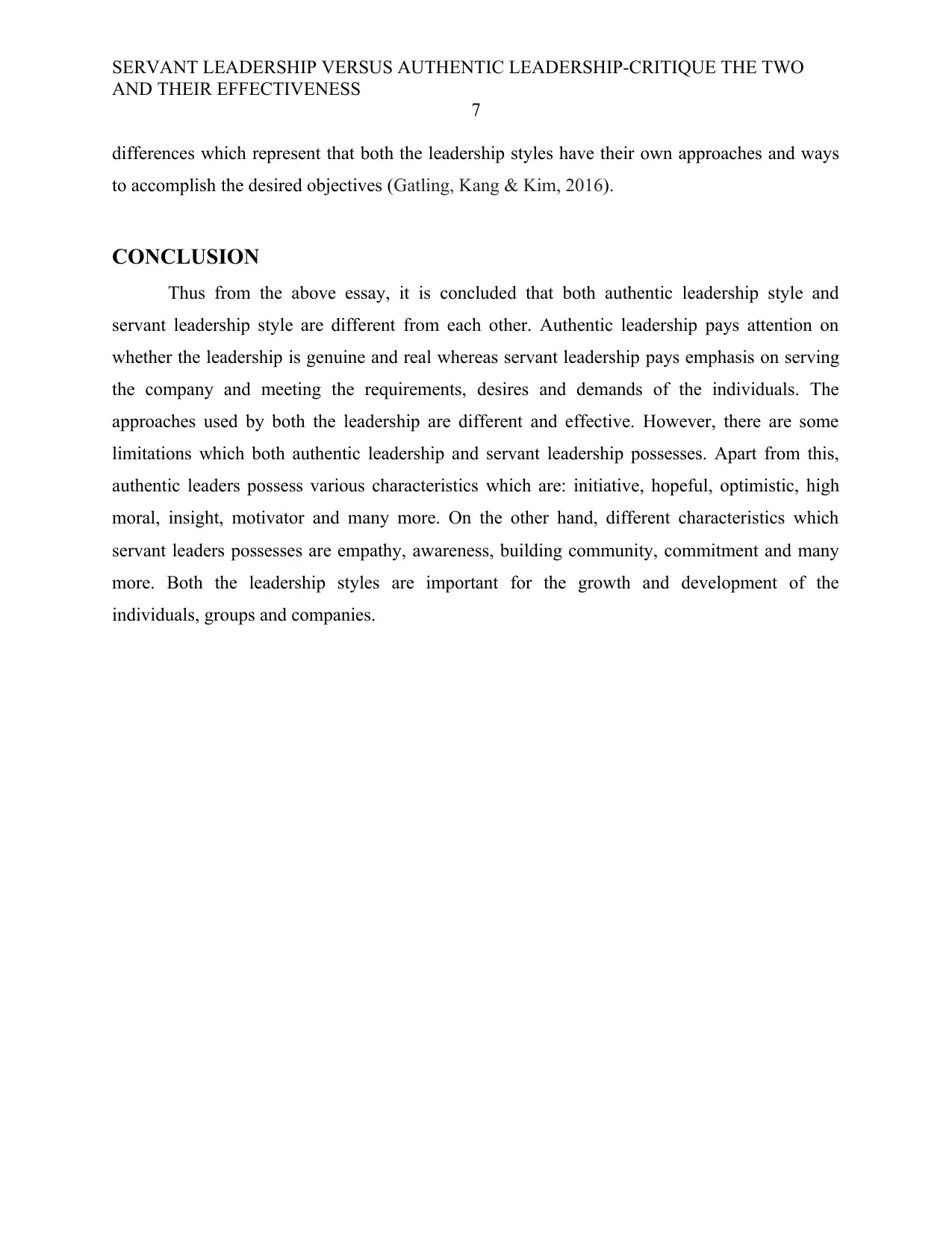
SERVANT LEADERSHIP VERSUS AUTHENTIC LEADERSHIP-CRITIQUE THE TWO
AND THEIR EFFECTIVENESS
7
differences which represent that both the leadership styles have their own approaches and ways
to accomplish the desired objectives (Gatling, Kang & Kim, 2016).
CONCLUSION
Thus from the above essay, it is concluded that both authentic leadership style and
servant leadership style are different from each other. Authentic leadership pays attention on
whether the leadership is genuine and real whereas servant leadership pays emphasis on serving
the company and meeting the requirements, desires and demands of the individuals. The
approaches used by both the leadership are different and effective. However, there are some
limitations which both authentic leadership and servant leadership possesses. Apart from this,
authentic leaders possess various characteristics which are: initiative, hopeful, optimistic, high
moral, insight, motivator and many more. On the other hand, different characteristics which
servant leaders possesses are empathy, awareness, building community, commitment and many
more. Both the leadership styles are important for the growth and development of the
individuals, groups and companies.
AND THEIR EFFECTIVENESS
7
differences which represent that both the leadership styles have their own approaches and ways
to accomplish the desired objectives (Gatling, Kang & Kim, 2016).
CONCLUSION
Thus from the above essay, it is concluded that both authentic leadership style and
servant leadership style are different from each other. Authentic leadership pays attention on
whether the leadership is genuine and real whereas servant leadership pays emphasis on serving
the company and meeting the requirements, desires and demands of the individuals. The
approaches used by both the leadership are different and effective. However, there are some
limitations which both authentic leadership and servant leadership possesses. Apart from this,
authentic leaders possess various characteristics which are: initiative, hopeful, optimistic, high
moral, insight, motivator and many more. On the other hand, different characteristics which
servant leaders possesses are empathy, awareness, building community, commitment and many
more. Both the leadership styles are important for the growth and development of the
individuals, groups and companies.
Paraphrase This Document
Need a fresh take? Get an instant paraphrase of this document with our AI Paraphraser
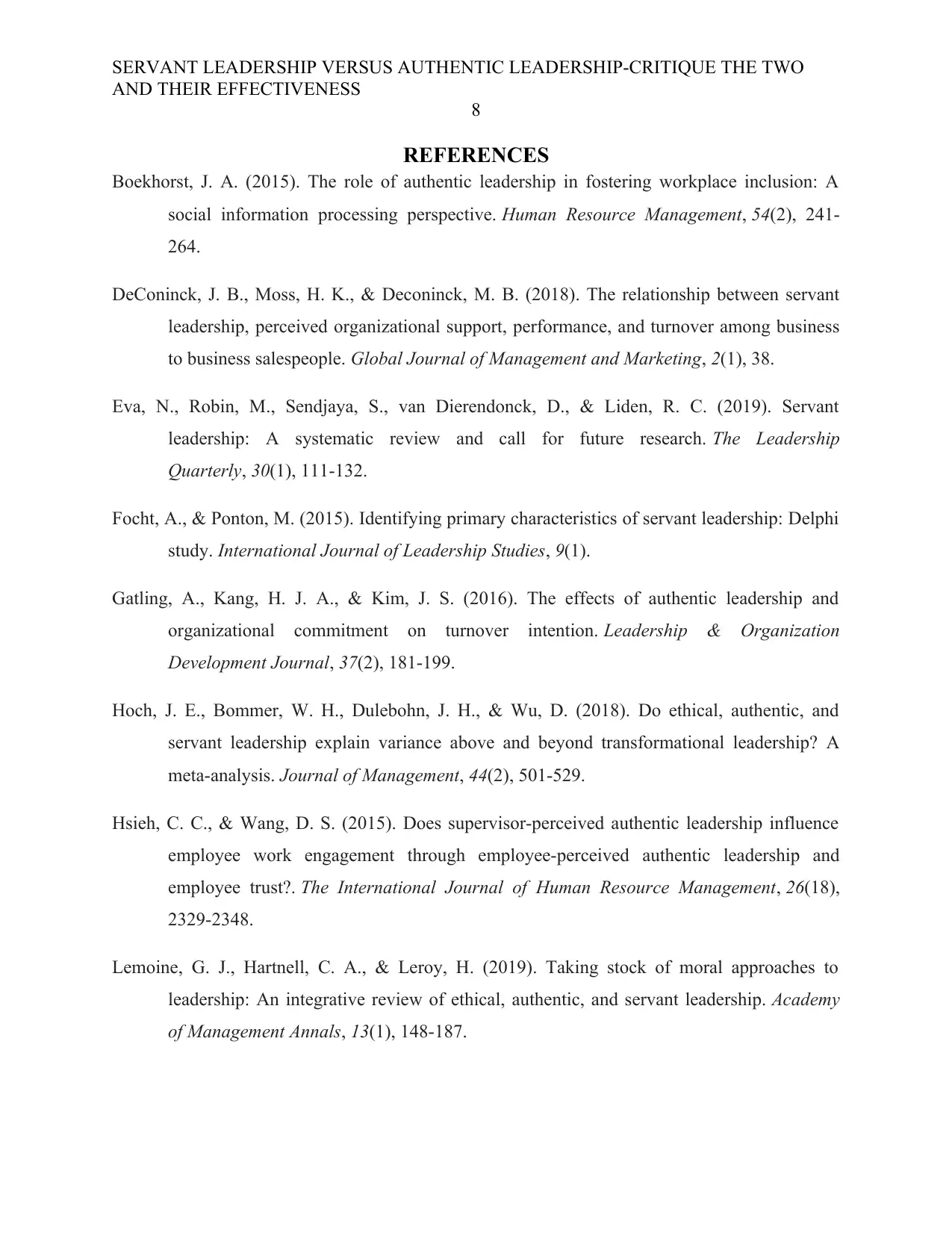
SERVANT LEADERSHIP VERSUS AUTHENTIC LEADERSHIP-CRITIQUE THE TWO
AND THEIR EFFECTIVENESS
8
REFERENCES
Boekhorst, J. A. (2015). The role of authentic leadership in fostering workplace inclusion: A
social information processing perspective. Human Resource Management, 54(2), 241-
264.
DeConinck, J. B., Moss, H. K., & Deconinck, M. B. (2018). The relationship between servant
leadership, perceived organizational support, performance, and turnover among business
to business salespeople. Global Journal of Management and Marketing, 2(1), 38.
Eva, N., Robin, M., Sendjaya, S., van Dierendonck, D., & Liden, R. C. (2019). Servant
leadership: A systematic review and call for future research. The Leadership
Quarterly, 30(1), 111-132.
Focht, A., & Ponton, M. (2015). Identifying primary characteristics of servant leadership: Delphi
study. International Journal of Leadership Studies, 9(1).
Gatling, A., Kang, H. J. A., & Kim, J. S. (2016). The effects of authentic leadership and
organizational commitment on turnover intention. Leadership & Organization
Development Journal, 37(2), 181-199.
Hoch, J. E., Bommer, W. H., Dulebohn, J. H., & Wu, D. (2018). Do ethical, authentic, and
servant leadership explain variance above and beyond transformational leadership? A
meta-analysis. Journal of Management, 44(2), 501-529.
Hsieh, C. C., & Wang, D. S. (2015). Does supervisor-perceived authentic leadership influence
employee work engagement through employee-perceived authentic leadership and
employee trust?. The International Journal of Human Resource Management, 26(18),
2329-2348.
Lemoine, G. J., Hartnell, C. A., & Leroy, H. (2019). Taking stock of moral approaches to
leadership: An integrative review of ethical, authentic, and servant leadership. Academy
of Management Annals, 13(1), 148-187.
AND THEIR EFFECTIVENESS
8
REFERENCES
Boekhorst, J. A. (2015). The role of authentic leadership in fostering workplace inclusion: A
social information processing perspective. Human Resource Management, 54(2), 241-
264.
DeConinck, J. B., Moss, H. K., & Deconinck, M. B. (2018). The relationship between servant
leadership, perceived organizational support, performance, and turnover among business
to business salespeople. Global Journal of Management and Marketing, 2(1), 38.
Eva, N., Robin, M., Sendjaya, S., van Dierendonck, D., & Liden, R. C. (2019). Servant
leadership: A systematic review and call for future research. The Leadership
Quarterly, 30(1), 111-132.
Focht, A., & Ponton, M. (2015). Identifying primary characteristics of servant leadership: Delphi
study. International Journal of Leadership Studies, 9(1).
Gatling, A., Kang, H. J. A., & Kim, J. S. (2016). The effects of authentic leadership and
organizational commitment on turnover intention. Leadership & Organization
Development Journal, 37(2), 181-199.
Hoch, J. E., Bommer, W. H., Dulebohn, J. H., & Wu, D. (2018). Do ethical, authentic, and
servant leadership explain variance above and beyond transformational leadership? A
meta-analysis. Journal of Management, 44(2), 501-529.
Hsieh, C. C., & Wang, D. S. (2015). Does supervisor-perceived authentic leadership influence
employee work engagement through employee-perceived authentic leadership and
employee trust?. The International Journal of Human Resource Management, 26(18),
2329-2348.
Lemoine, G. J., Hartnell, C. A., & Leroy, H. (2019). Taking stock of moral approaches to
leadership: An integrative review of ethical, authentic, and servant leadership. Academy
of Management Annals, 13(1), 148-187.
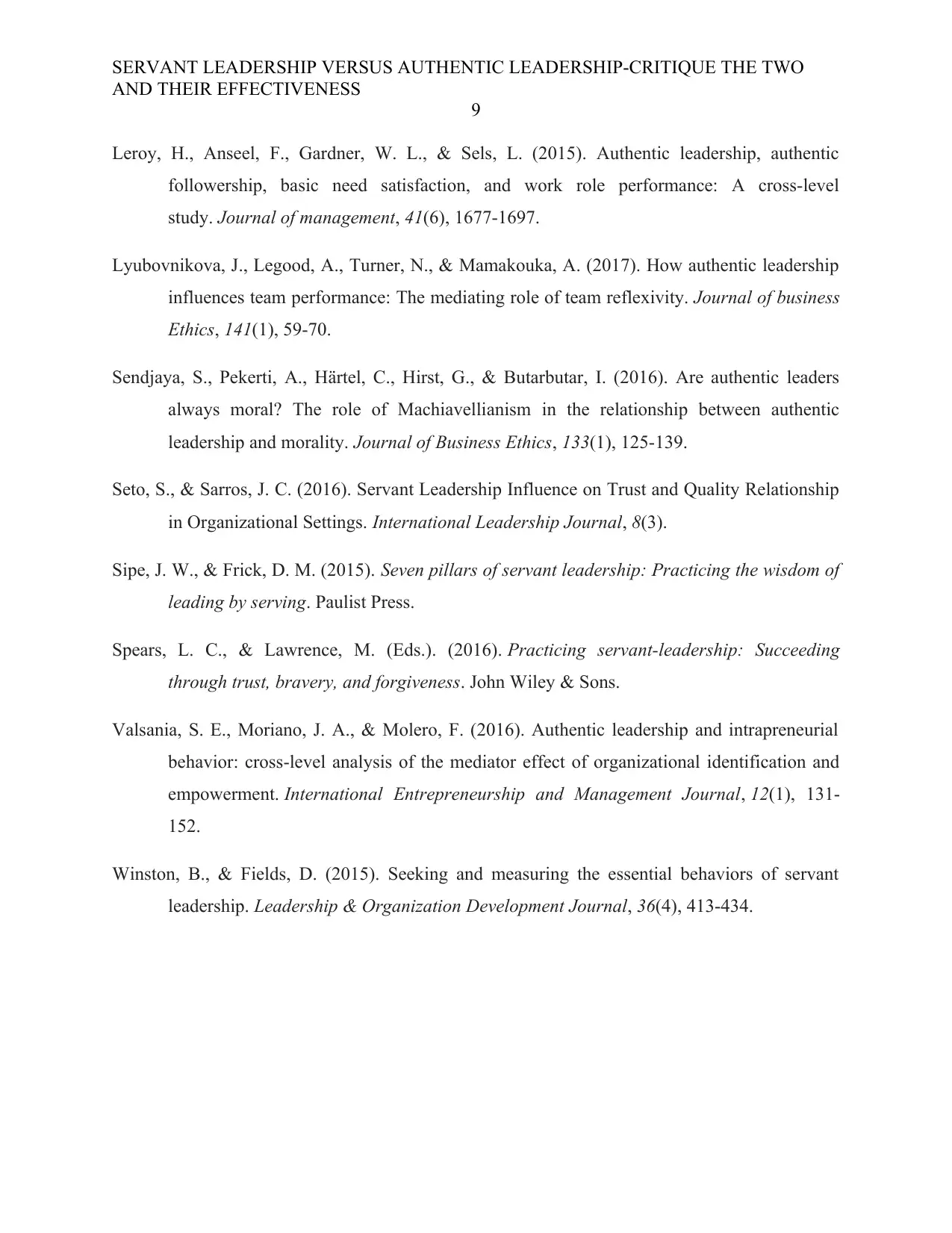
SERVANT LEADERSHIP VERSUS AUTHENTIC LEADERSHIP-CRITIQUE THE TWO
AND THEIR EFFECTIVENESS
9
Leroy, H., Anseel, F., Gardner, W. L., & Sels, L. (2015). Authentic leadership, authentic
followership, basic need satisfaction, and work role performance: A cross-level
study. Journal of management, 41(6), 1677-1697.
Lyubovnikova, J., Legood, A., Turner, N., & Mamakouka, A. (2017). How authentic leadership
influences team performance: The mediating role of team reflexivity. Journal of business
Ethics, 141(1), 59-70.
Sendjaya, S., Pekerti, A., Härtel, C., Hirst, G., & Butarbutar, I. (2016). Are authentic leaders
always moral? The role of Machiavellianism in the relationship between authentic
leadership and morality. Journal of Business Ethics, 133(1), 125-139.
Seto, S., & Sarros, J. C. (2016). Servant Leadership Influence on Trust and Quality Relationship
in Organizational Settings. International Leadership Journal, 8(3).
Sipe, J. W., & Frick, D. M. (2015). Seven pillars of servant leadership: Practicing the wisdom of
leading by serving. Paulist Press.
Spears, L. C., & Lawrence, M. (Eds.). (2016). Practicing servant-leadership: Succeeding
through trust, bravery, and forgiveness. John Wiley & Sons.
Valsania, S. E., Moriano, J. A., & Molero, F. (2016). Authentic leadership and intrapreneurial
behavior: cross-level analysis of the mediator effect of organizational identification and
empowerment. International Entrepreneurship and Management Journal, 12(1), 131-
152.
Winston, B., & Fields, D. (2015). Seeking and measuring the essential behaviors of servant
leadership. Leadership & Organization Development Journal, 36(4), 413-434.
AND THEIR EFFECTIVENESS
9
Leroy, H., Anseel, F., Gardner, W. L., & Sels, L. (2015). Authentic leadership, authentic
followership, basic need satisfaction, and work role performance: A cross-level
study. Journal of management, 41(6), 1677-1697.
Lyubovnikova, J., Legood, A., Turner, N., & Mamakouka, A. (2017). How authentic leadership
influences team performance: The mediating role of team reflexivity. Journal of business
Ethics, 141(1), 59-70.
Sendjaya, S., Pekerti, A., Härtel, C., Hirst, G., & Butarbutar, I. (2016). Are authentic leaders
always moral? The role of Machiavellianism in the relationship between authentic
leadership and morality. Journal of Business Ethics, 133(1), 125-139.
Seto, S., & Sarros, J. C. (2016). Servant Leadership Influence on Trust and Quality Relationship
in Organizational Settings. International Leadership Journal, 8(3).
Sipe, J. W., & Frick, D. M. (2015). Seven pillars of servant leadership: Practicing the wisdom of
leading by serving. Paulist Press.
Spears, L. C., & Lawrence, M. (Eds.). (2016). Practicing servant-leadership: Succeeding
through trust, bravery, and forgiveness. John Wiley & Sons.
Valsania, S. E., Moriano, J. A., & Molero, F. (2016). Authentic leadership and intrapreneurial
behavior: cross-level analysis of the mediator effect of organizational identification and
empowerment. International Entrepreneurship and Management Journal, 12(1), 131-
152.
Winston, B., & Fields, D. (2015). Seeking and measuring the essential behaviors of servant
leadership. Leadership & Organization Development Journal, 36(4), 413-434.
⊘ This is a preview!⊘
Do you want full access?
Subscribe today to unlock all pages.

Trusted by 1+ million students worldwide
1 out of 9
Related Documents
Your All-in-One AI-Powered Toolkit for Academic Success.
+13062052269
info@desklib.com
Available 24*7 on WhatsApp / Email
![[object Object]](/_next/static/media/star-bottom.7253800d.svg)
Unlock your academic potential
Copyright © 2020–2025 A2Z Services. All Rights Reserved. Developed and managed by ZUCOL.





